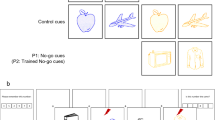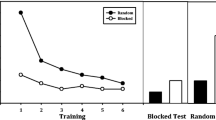Abstract
The ability to inhibit previously learned visuomotor associations is essential for efficient learning of novel behaviors. While the neural basis of the system that might control interactions between competing motor memories is not known, it has been demonstrated that animals with ventral and orbital prefrontal cortex (PFC) deficits have particular difficulties in learning to withhold responses to previously conditioned sensory stimuli. Here we measured regional cerebral blood flow (rCBF), using positron emission tomography, during learning of a novel motor task that required inhibition of a previously learned motor memory. Subjects (n=24) learned reaching movements in a force field (field A). After a variable time interval, some subjects (n=15) learned to reach in a field with a reversed pattern of forces (field B). When the time interval was short (10 min), learning in field B was coincident with a reactivation of regions that had become initially activated during learning in field A: the left putamen and bilaterally in the dorsolateral PFC. Behaviorally, this was accompanied with perseveration that lasted for hundreds of movements, suggesting an instantiation of the internal model for field A during learning in field B. Neither the reactivation nor the perseveration were observed in a different group of subjects that learned field B at 5.5 h. We found that the regions which significantly differentiated the two groups during learning of B were in the ventrolateral PFC (bilaterally): there were sharp decreases in rCBF here in the 5.5 group but not in the 10-min group. At 5.5 h motor learning again involved the striatum, but this time in the left caudate. Neither the caudate nor the ventral PFC had exhibited learning-related activity in field A. Instead, they showed changes in rCBF during the reversal of the learning problem when the previously acquired motor memory was successfully gated. The results demonstrate that: (1) perseveration of a competing motor memory may be linked to reactivation of the neural circuit that participated in acquiring that memory, and (2) the ventral PFC may play an important role in the inhibitory control of the competing motor memory.
Similar content being viewed by others
Author information
Authors and Affiliations
Additional information
Received: 30 July 1998 / Accepted: 20 December 1998
Rights and permissions
About this article
Cite this article
Shadmehr, R., Holcomb, H. Inhibitory control of competing motor memories. Exp Brain Res 126, 235–251 (1999). https://doi.org/10.1007/s002210050733
Issue Date:
DOI: https://doi.org/10.1007/s002210050733




